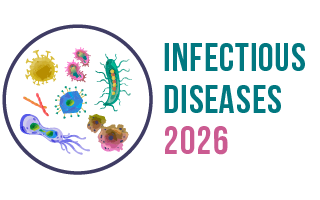4th International Conference on
Infectious Diseases
September 09-10, 2026 | Barcelona, Spain

Address: Avinguda Del Maresme 78 Ronda De Dalt Exit 15, 08940 Comella de Llobregat, Barcelona, Spain
Infectious Diseases 2026

Mekelle University, Ethiopia
Abstract:
Background:Oropharyngeal candidiasis (OPC) is the most common opportunistic infection encountered among human immunodeficiency virus-infected patients and is considered an independent predictor of immunodeficiency in patients with acquired immunodeficiency syndrome (AIDS). Though Candida albican is the most frequently isolated species from the oropharyngeal lesions, the change in the spectrum of Candida species as the causative agent of oropharyngeal candidiasis and increased antifungal drug resistance among HIV-infected individuals has made the identification of Candida species and determination of its drug resistance pattern is necessary for the routine patient care.
Objective:Therefore, the study aimed to determine the prevalence, antifungal susceptibility pattern, and associated factors of Candida species among HIV-positive individuals having oropharyngeal legions in Mekelle Health Facilities of Tigray, Ethiopia
Method:A cross-sectional study was conducted among 381 HIV-positive individuals with oropharyngeal lesions from September 2017 to May 2018 Socio demographic and clinical data and oral swabs were collected from the study participants. Collected swab samples were transported to the Microbiology laboratory, College of Health Sciences, Mekelle University, and cultured onto sabouraud dextrose agar with chloramphenicol. All the isolates were characterized using germ tubes and Crome Candida agar tests. The antifungal susceptibility patterns of all Candida species were determined using the disk diffusion method and data were analyzed using STATA version 13.0.
Result:Among the 381 study participants, the overall Candida species were isolated from 228(59.8%). A total of 240 Candida species were isolated, of which C. albican was the most predominant 151(62.9%). Among the non-albican Candida species, the most predominant species were Candida glabrata 47(19.6%) followed by Candida tropicalis 26 (10.8%) and Candida krusei 16 (6.7%), and the majority of the isolates were from HAART naïve 127(52.9%) and those on HAART were 113 (47.1%). Age group 40-49 years (p = 0.019), previous history of antifungal drug treatment (p=0.039), CD4 counts < 200 cells/mm3 (p=0.003), HAART naïve (p=0.000), body mass indices
Biography:
Haftay Abraha Tadesse was born and raised in Tigray, Northern Ethiopia. He completed his primary education in Maynebri and pursued his secondary education at Adi-guide Comprehensive Secondary School. Haftay earned both his BSc in Animal Health and MSc in Medical Microbiology from Mekelle University. He has held positions in teaching and research at Mekelle University, where he currently teaches Molecular Biology, Microbiology, and Biochemistry at the College of Veterinary Science. His expertise encompasses various areas, including food and medical microbiology, mycology, virology, public health (focusing on zoonosis and food safety), and molecular biology. Additionally, Haftay is involved in conducting studies in microbiology and molecular biology, specifically related to antimicrobial resistance (AMR) and drug screening across different streams.
